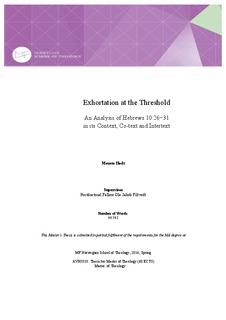Exhortation at the Threshold: An Analysis of Hebrews 10:26−31 in its Context, Co-text and Intertext
Master thesis
Permanent lenke
http://hdl.handle.net/11250/2432816Utgivelsesdato
2016Metadata
Vis full innførselSamlinger
Sammendrag
This thesis investigates how the claim made in Hebrews 10:261 can be regarded as valid, given what the letter to the Hebrews, generally has to say about the new covenant inaugurated by the sacrificial death of Jesus; and analyzes Hebrews 10:26–31 within its context2, co-text3 and intertext.4 It has attempted to come to terms with both the meaning and the function of the text within the rhetorical strategy of the anonymous author.
Hebrews constructs a “scriptural world” for its audience by inscribing them into the meta-narrative of Israel, that was begun but not completed in the OT. Jesus is presented as the one who has brought that narrative to its fulfillment by his ministry as high priest and covenant mediator, and he is the leader who will bring his followers to their inheritance. The recipients are in a situation analogue to that of Israelites at the threshold to Canaan, and its exhortation echoes Deuteronomy, calling the covenant people to renewed loyalty and commitment so that they will not die but live.
Hebrews 10:26–31is thus analyzed against the backdrop of Israel’s meta-narrative. The new covenant is greater than the old covenant, thus more is at stake if it is broken. There is a tension between promise and obligation also in the new covenant, but the obligation is not directed towards the law but rather following Jesus, the Son of God.
